Introduction
Indian cultural heritage has been the product of two streams of thought and practices – first is folk traditions that belong to the oral traditions that operate at folk levels, secondly those that belong to sophisticated literary traditions. Vedic cultures gave rise to the classical traditions. Though the two are inter dependent yet the roots of the higher traditions lie in the little traditions.
Jump To Section
Harappa
During the Indus Valley Civilisation a vast number of Harappan pottery sherds, amulets, seals, miniature carving in clay, metal and semi-precious stones have been discovered at Indus Valley sites. A narrative art is evident in the pictograph seals, undeciphered script and on pottery. The knowledge of geometry and the sacred nature of abstract forms that were later developed into mandana and alpana. A living ritual and technology that dates back five thousand years is manifest, linking rites and symbols with the contemporary art and ritual of village and tribes. This gives to the rural art of today a time free perspective within which the past and present coalesce in a great convolving continuity
Figurines
The Harappan civilisation produces evidence of the universal popularity of stone, bronze and terracotta figurines whether as toys or as cult objects. A male torso of red sand stone , 4″ in size, is a finer Harappan stone sculpture. Less plentiful than stone sculpture are those of cast bronze mainly from Mohenjodaro. The most significant specimen is a dancing girl’ figure. Among Terracotta figurines human figurines are less common then animals. Both male and female figures are found, later being more common. A definite type of series emerges called mother goddesses, their headdress is elaborate.
Pottery
The painting of pottery appears almost from the beginning of settlement in Baluchistan. The most common element are linear and simple geometric designs but occasionally animals are found. These decorative designs soon blossom into complex patterns including flora and fauna in naturalistic and realistic representations.
Seal
Seals are an impressive part of surviving art of Harappan culture. Of these the great majority have animals engraved on them and a short inscription. Other animals are elephant, bison, rhinoceros and tiger. Of special interest is a considerable group of seals with cult motifs. The cult scenes show a refreshing originality.
Toys
Among toys animal figurines are most common. Among animals most common subject is Bos indicus quite often with heavy and exaggerated hump. Other animals are sheep and birds. Among bronze a fine buffalo and a ram is noteworthy. Among toys the little model of bullock carts are interesting.
Ajanta(200BC-600AD)
Jawahar Lal Nehru once said “Ajanta takes us back into some distant dream like but a very real past”.
Ajanta rock art is a combination of three arts – architecture, sculpture and painting. Buddhist monks excavated rocks to form these caves for praying, for meditation and for residing. The serene natural surroundings of the area made Ajanta an ideal place for Buddhist monks to seek the “path” and for artisans to carve monuments dedicated to the Lord Buddha.
The art of Ajanta caves is well known for its creativeness and artistic excellence. It is perhaps, the greatest art centre of the Gupta period Buddhist creative visual enterprises of India. Nowhere else at one place, is shown such a grand display of the three disciplines- architecture, sculpture and painting in a highly mature and technically perfect state. In the realm of painting it is almost unique and unparalleled in the contemporary world of art.
The importance of Ajanta in the history of Indian art is great. Any attempt to state it in precise terms would appear exaggerated and yet be inadequate. No other source including literature would be equal to it. A single picture of Ajanta can communicate the meaning better than a thousand words. It is a simple visual representation of Buddhist ideals and religious sentiments that are present in today’s world record of paintings in Asia.
At a quiet secluded spot, at the edge of the Deccan plateau and on the border of Khandesh, in an atmosphere that is at once serene and yet vibrant with the vitality of nature. There are 29 rock cut Buddhist temples and monasteries, forming a majestic semicircular amphitheatre. Ajanta caves were discovered by British soldiers in 1819. The caves are in the form of a string of pearls around the waist of a mountain and are located near the source of river Vaghora near Aurangabad, a district town about 400 kms east of Mumbai. It turned out after some research that these were Buddhist monasteries. Soon after the discovery, the caves attracted attention of eminent archaeologists and art historians from all over the world.
Paintings in Caves 1,2,16, and 17 are not only beautiful, but are also a vivid record of life and the times in the fifth century.
Ellora
The first Hindu caves were erected at Ellora. In Ellora caves, themes are drawn from Hindu mythology, the Puranas and epics Mostly the scenes are dedicated to Siva, one of the god of Hindu trinity. Siva’s many manifestations suggests his multiple attributes as the personification of death and time(mahakala), as mahayogi and the Lord of Dance. The various aspects of female energy are also portrayed. Origin of this at Ellora is scattered over the India continent.
Buddhists caves in Ellora represent a vast pantheon of Buddhas, Bodhisattvas and shaktis suggests a specific philosophy, generally known as Vijrayana cult. During this period the female energy (sakti) was considered to be an integral part of the Bodhisattvas. In Ellora Jain monasteries are small in number They mainly represent the Digambara sect.
Fragments of painting covering walls and ceilings suggest that the classical mural decorative traditions evolved at Ajanta were continued here too. They portray variety of subjects such as iconographic forms, decorative designs and floral and geometric designs.
Temple Art
The Indian cultural milieu in its entirety was built around the temples which were centers that patronized all arts and architecture. There is a certain unity reflecting the independence and interrelationship among the various temple arts.
Most of the ancient paintings are vanished. Those that remained are now in a very bad condition But the surviving remains of ancient paintings are sufficient to show its achievement. They are mostly found as murals in temples. Paintings found in cave temples of Ajanta (2ndBC-6thAD) are the best example of temple wall paintings. They are based on the life of Gautama Buddha and his previous lives. In Hindu religion, myths and legends we have some more examples of temple wall paintings of 16th and 17th c. Two types are paintings are found in temples: Wall Paintings and Paintings on cloth
Anegadi Temple
Anegadi Only few remnants survived to tell us of the magnificient culture. The murals showing Mchayappa Matoo in Anegadi are in traditional Indian style. The old mural technique of painting on lime plaster is followed. The figures are painted in red, yellow and lapis luzuli blues, have not faded. The rich exuberance of finely rounded human figures, emerging from background of flowers, elephants and clouds, there is evident, a fine energy and flow reminiscent of the Chola artists of the previous centuries.
Lipakshi temple
In Anandpur district of Andhra Pradesh there is a temple dedicated to the worship of Veerabhadra. Here five frescoes of sixteenth century AD draw our attention. The paintings of Lepakshi show a completely different character, totally dissimilar to the familiar ancient classical styles of India. There is a resemblance in style beween Lepakshi paintings and the present day figurative drawings of Srikalahasti kalamkari ar. The painting style is both descriptive and decorative.
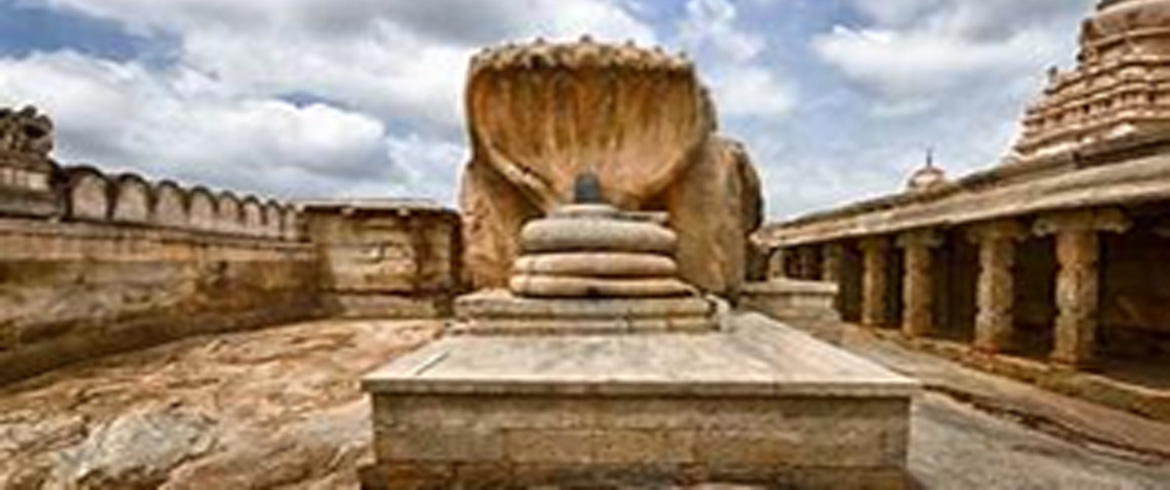
Madnapur Temple
Traces of narrative paintings found on ceiling of Vishnu Temple at Madanpur, near Lalitpur in UP. Temple was built at the time of Raja Madan Verma (1130-1165). The paintings are added later. The angular flying figures, with pointed noses, extended eyes and dresses in patterned light fitting costumes, have affiliations with Jain characters in medieval palm leaf Kalpasutras also with eastern Indian palm leaf Manuscript paintings. The conventional lotus, peacock and other decorations.
Nathdwara Temple
Nathdwara is a small pilgrimage town in Udaipur district, Rajasthan . The word Nathdwara means gateway to the Lord. Nathdwara has been the head quarters of the chief deity of the Pushtimarga sect, founded by Sri Vallabhacharya in the sixteeth century. In Nathdwara , art is the occupational heritage of the whole joint family. There are two different painter sub castes , the Jangira Brahmins and the Adi Gour Brahmins. Painters from many places migrated to the site in hopes of royal and religious patronage.
Nayaka paintings
Around 1565 AD Vijayanagara kingdom gave rise to several small kingdoms ruled by chieftains. Among them were nayakas of Tanjavur, Vellore and Madurai. They were lavish in their patronage of arts particularly sculpture and paintings which flourished under them. Artists of this period gave rise to a wide variety in stylistic details and treatment of their art. The characteristic can also be discerned in temple hangings and Deccani miniatures, and is found in Kalamkari paintings of Srikalahastri even today.
Tiruvarur Temple Paintings
The temple of Tiruvarur is in Thanjavur district and is one of the more venerated shrines of southern Saivism. The innermost shrine of the temple is dedicated to Siva as Tyagaraja. According to legend, one Sivaratri, a monkey perched on a tree inadvertently dropped bilva leaves on a Sivalinga below. Pleased with this innocent act , Siva blessed the monkey who was reborn as Muchukunda, the early Chola monarch. This popular legend of Muchukunda transporting the statue of Tyagaraja down to earth is vividly described in ceiling paintings of the thousand pillared mandapa commissioned in late seventeenth and early eighteenth centuries, during the Nayaka period.
Tiruparutikunram Temple
Here are two temples dedicated to Chandraprabha and Vardhamana. They have the main features of the highly coloured , south Indian style. In the varandas and near mandapa are wall paintings, showing scenes from Jain mythology and the life of tirthankaras. The firmly drawn figures show little movement. But the vivid colours are laid on lyrical wseeps. The forms are not aggrasive, as in Jain books. Basic colours as well as the secondary mixture and some sense of projecting relief as in sculpture.
Tirumalaipuram Temple
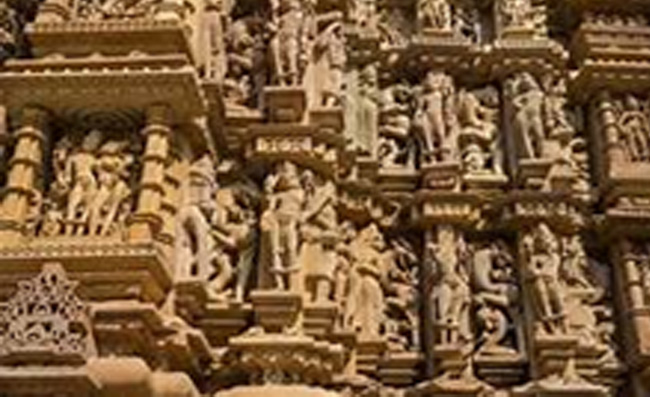
The fragments of wall paintings in Tirumalaipuram found under the Pandya Dynasty of 8th. C. AD. One of the important surviving panel are from Lakshman mandap shows bird headed devtas among the figures as in Ellora, and with fish eyes and sharp noses, amidst clouds. They are steaked in ochre and red with flame like outlines. These paintings are full of spirit as at Ajanta, but with a warm sensuous inner glow. There is a masterly handling of line, which carried forward the earlier Pallava tradition, enriched by shavaite passion, that had begun to possess the Deccan Peninsula.
Murals of Thodikkalam Temple
Thodikkalam, a small village has remarkable artistic examples of mural paintings dating from the 16th c to 18th c AD. The temple, dedicated to Rudra, was built by Harish Chandra Perumal, founder of Kottayam dynasty. Mural paintings are on four walls of two storeyed sanctuary built in a traditional architectural style of Kerala. Mural paintings and ornamentation cover outer walls. Paintings are mainly based on Saiva and Vaisnavite stories. The cosmic dance of Siva is the most important mural. Nataraja, dancing on a malignant dwarf and Nandikeswara’s thrill in witnessing the cosmic dance have, over time, been reduced to faded lines, devoid of colour.
Vijainahgara Temple art
The earliest of the Vijayanagara period temples include Shaiva temples on the sloping rocky shelf of Hemakuta hill, immediately above the modern village of Hampi. They are built in a style very similar to the pre-Vijayanagara shrines that were already extant on the hill. Another temple of this type is Narasimha temple, situated on the south bank of the river and is dedicated to the Vaishnava deity. A nearby inscription reveals that it was already in existence in AD 1379. This temple and the ones on Hemakuta have pyramidal stone superstructures, with recessed horizontal mouldings. The core of the Prasanna Virupaksha temple in the ‘royal centre’ is also of the fourteenth century, and was dedicated to the same divinity as the one worshipped in the principal temple at Hampi.
Pichwai
Pichwai means, in the background. Themes evoking the myraid moods or leelas of Lord Krishna were painted on cloth of varying sizes that were hung behind the idol of Lord Krishna in Vallabhacharya shines.These temple and havelis hangings are called pichwais. Offered to Srinathji at Nathadwara in Rajasthan by the devout on auspicious days, festivals and seasons, pichwais gradually developed into a special and distinct style of paintings.
Miniature Paintings
Miniature paintings present a very fascinating and varied history of its evolution and achievements. The earliest known miniatures were painted on palm leaves in Eastern India between the 10th and 12th centuries. Earliest known miniatures were painted on palm leaves in Eastern India and Tibet beween 10th and 12th centuries. Western Indian Jain miniature paintings developed with a remarkable record and spread over five centuries (1100-1600 c). The best paintings belong to the transition period (1350-1450 c.), when paper was substituted for palm leaf. These are distinguished by the smallness of size, decorative figures and short -statured men and women with angular faces, pointed noses and protruding eyes. Earlier miniatures show a brick red background and simple colour scheme. From the 15th c onwards we find a use of blue and golden colour on a lavish scale. The outline is picked in red and colours employed are gold, yellow, black, white, blue, green and pink. Many illustrated manuscripts were produced during this period. Some of them are Kalpasutra and Kalakacharya Katha, Balagopalastuti, DurgaSaptasati, Vasanta -Vilas and RatiRhasya. Paintings from Mandu Kalpsutra have typical Jain colours, ultramarine and Indian red gives the most decorative appeal to paintings of the coronation of Mahavira. The Pala style depicts supple naturalism.
The Mughals brought this art of miniature paintings from Iran. Shahnama, the Book of Kings of Iran, was composed by Quasim Mansur. The title of the book was ‘Firdausi’ – ie. ‘Heaven’. Mansur composed sixty thousand couplets for Shahnama and completed this work in 30 years. Furdosi Shahnama was written in Persian and tales of valour of the fifty kings of Iran. Each of the fifty chapters high light the glory and achievements of the kings. It also throws light on the social customs, traditions, feasts, festivals and cultural aspect of Iranian life.
Although Islamic footholds in India were made as early as the first half of the 10th century, it wasn’t until the Mughal Empire that one observes emperors with a patronage for the fine arts. Emperor Humayun, during his reestablishment of the Delhi Sultanate in 1555, brought with him Mir Sayyad Ali and Abad Samad, two of the finest painters from Persian Shah Tahmasp’s renowned atelier.
Mughal school flourished under three emperors Akbar(1556-1605), Jahangir (1605- 1627), and Shahjahan (1627- 1658).During their time there were number of artists both Hindu and Muslim along with two Iranian painters named Mir Sayyad Ali and Abdus-Samad The result was that a new style emerged mixing Hindu and Muslim elements with those of Iran.
Mughal paintings reveal a classical greatness, rich style and distinctive inspiration. They present a very fascinating and varied history of its evolution and achievements. The best paintings belong to the transition period (1350-1450 c.)
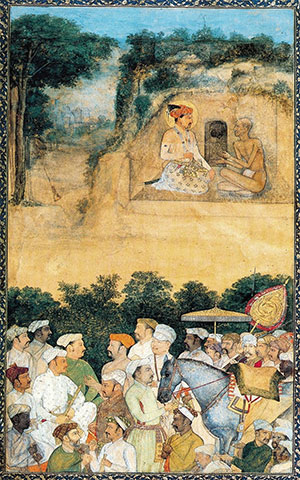
Mughal Miniature Paintings
Mughal school flourished under three emperors Akbar(1556-1605), Jahangir (1605- 1627), and Shahjahan (1627- 1658). Their paintings reveal a classical greatness, rich style and distinctive inspiration.
There are number of artists both Hindu and Muslim along with two Iranian painters named Mir Sayyad Ali and Abdas-Samad The result was that a new style emerged mixing Hindu and Indian Muslim elements with those of Iran.
Minute details, general finish, mixing of colours and bold execution distinguished these paintings from the stylised Persian paintings and gradually became more and more Indian in feature and expression.
Among the illustrated works, the Dastan-i-Amir Hamza was a massive work. Other works are Laila Majnu, Dhabnamab, Khamsa of Nizami, Razmnamab, Mahabharat, Babarnamah and Akbarnamah. Basawan, Daswanth, Nanha and Bihandas were some of the most famous painters of Akbar’s court. Early Mughal art is purely masculine and the activities of women never recorded.
Pahari Miniatures
Pahari miniature paintings belong to the hills of Rajput states of Punjab hills extending from Tehri Garhwal in the east to Jammu in the west. The art of miniature paintings was brought to the Punjab from Mughal and Rajput states and along the way it collected the tradition of both schools. Various schools grew up in the region differed according to the states that fostered them. The important centers of Pahari paintings are Basohli, Gular Chamba, Jammu Nurpur, Bilaspur, Mandi, Kullu, and Kangra. Despite political disturbances during 18th and 19th c. the isolated hill states were enjoying their prosperity and attracted many artists who developed a superb sense of composition and expressed their deep feelings for human emotions in a serene and picturesque setting.
From the court art under the Mughals, miniature paintings, by the time it reached the hills, had become a vehicle for expression of the painter’s feelings and beliefs in religion and love. A whole series of miniatures depicting was painted in this area on various incidents from the life of Krishna or one of the great epics. These were not done in any order, but according to the fancy of the artist or his patron. Since they were not meant for book illustration, a few lines of the text is found either on the back or margin of the picture describing the incident depicted.
Apart from mythological depictions the miniatures also featured portraits, and women playing ball, or musical instruments, amusing themselves with birds and animals, bathing, letting fireworks, at their toilets, or playing checkers. Naik Nayika were found in various moods. Heroine occupied a prominent place in Pahari paintings.
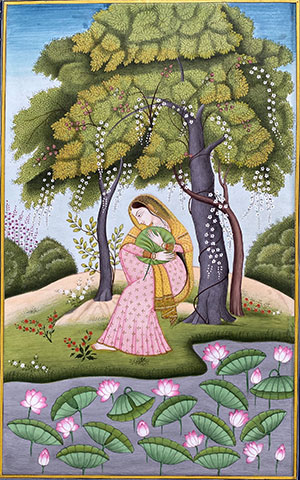
Rajasthan Miniatures
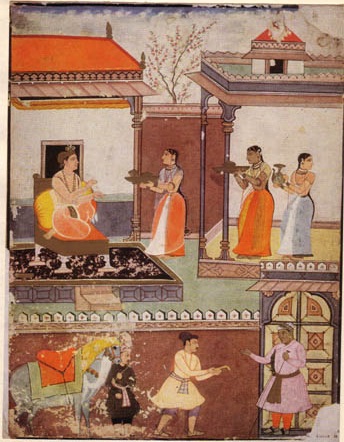
Rajasthani Miniatures took root in the first half of the 16th c. and reached a high watermark during the 17th c. and retained the technical perfection and vitality during the 18th c. Rajasthan was divided into princely states of varying sizes and strengths. Between Jain and Mughal periods, the style of painting in these areas formed a halfway house bridging the two schools. Architecture was represented by a small single storey building canopied, with slender pillars. There was folk look to the whole composition and drawing lacked finish and sophistication, but the former stylization was replaced by a new naturalism.
The particular miniatures that are known as Rajasthani miniature came into being only after 17thc, when flourishing Mughal School fused with the existing Jain school to produce a style of its own.
Their creative activity span covers a much wider area beyond the political boundaries with Udaipur, Jodhpur, Jaipur, Bikaner and Bundi as principal centers. The outstanding Rajput schools are Mewar, Jaipur, Jodhpur, Bikaner, Bundi, Kishangarh, and Kotah. Kishangarh also produced some of the masterpieces of the Rajasthani miniatures. Almost every court patronized its own artists. The unique richness of warm colours of Rajasthan is unknown in any other school.
Deccan Miniature Paintings
Vindhya mountain divided India into two zones south and north. Deccan- Persian meaning south- has maintained itself as separate entity culturally from north. Deccan forms a confederacy of five kingdoms – Besar, Bidar, Golcunda, Bijapur, and Ahmadnagar became three independent kingdoms of Golconda, Bijapur, and Ahmednagar absorbing Berar and Bidar by them.
In Deccan a distinctive style of painting developed in the court of Bijapur rulers. Nujumal-Ulam (1570 AD) is the earliest example of illustrated manuscripts. The Deccan school combines various elements of Western Indian School and the Persian art. Gradually Mughal influence became more and more prominent. The other important schools of Deccan are Ahmadnagar and Golkunda. Hindu influence in fakirs and sadhus and women was noticeable. By the end of 18th c. paintings became more ornate, with a distinct penchant for portraiture and harem scenes. Hunting scenes, a favourite of Mughals, are seldom met with. Bijapur and Golkunda artists were influenced by Mughal techniques but their works cannot be compared with that of naturalism, as they were always endowed with mystic and spiritual qualities.
The tradition of wall paintings continued up until the great Vijayanagara Empire.

Company Art
The Company style of paintings became common, created by Indian artists working for European patrons of the East India Company. British colonial rule had a great impact on Indian art. Indian artists welcomed the opportunity to work for their new British patrons, especially because the traditional patronage of Indian rulers and their courts was rapidly declining. Old patrons of art became less wealthy and influential, and Western art more ubiquitous as the British Empire established schools of art in major cities. The style was mainly Romanticized, By1858, the British government took over the task of administration of India under the British Raj. The fusion of Indian traditions with European style at this time is evident from Raja Ravi Verma’s oil paintings of Indian women in a graceful manner.
Company style or Company painting (style of paintings made in India by Indian artists, many of whom worked for European patrons in the British East India Company or other foreign Companies in the 18th and 19th centuries. The paintings were executed with water colour the primary medium used to convey soft textures and tones.The style blended traditional elements from Rajput and Mughal painting with a more Western treatment of perspective, volume and recession. At the same time, they took care to preserve traditional elements. Most paintings were small, reflecting the Indian miniature tradition.
Favourite. Their favourite subjects were subjects were scenes of Indian daily life, local rulers, and sets of festivals and ceremonies, historic monuments with their novel architecture, people of different classes in colourful costumes, festivals and rituals, crafts and occupations, different mores of transport, and nautch girls.
Contemporary Art
During 18th century Indian culture started to take its own from and a new development of art forms are also started showing. With this establishment, came collaborations. Contemporary art leads to a lot of collaborations and this became more frequent for Chinese and Indian artist. There was a change in the styles of art and became less detailed and elaborate with new themes. There emerged some rising artist that are starting to combine both tradition and modern art to create a bridge between the styles.
In the late nineteenth century, the old traditions of painting had more or less died out which started by the British. During the colonial era, Western influences had started to make an impact on Indian art. Some artists developed a style that used Western ideas of composition, perspective and realism to illustrate Indian themes, Raja Ravi Verma being prominent among them The protagonists of Indian art such as Raja Ravi Verma drew on Western traditions and techniques including oil paint and easel painting.
Meantime a modern Indian art movement with the Bengal school of art was started which It was succeeded by the Santiniketan school and led by Rabindranath Tagore harking back to idyllic rural folk and rural life. The mantle of the Bengal School was taken up when Rabindranath Tagore established the visionary university of Santiniketan, a university focussed on the preservation and upliftment of Indian culture, values and heritage. This new school of art drew from the rich cultural heritage of India.
Despite its country-wide influence in the early years, the importance of the School declined. Those associated with this Indo-Far Eastern model included Nandla Bose, Binode Bihari Mukherji, B C Sanyal, Vinayak Shivaram Masoji, Beohar Rammanohar Sinha, and subsequently their students A Ramachandran, Tan Yuan Chameli, and a few others. The Bengal school’s influence on Indian art scene gradually started alleviating with the spread of modernist ideas post-independence.
By the time of Independence in 1947, several schools of art in India provided access to modern techniques and ideas. Galleries were established to showcase these artists. Modern Indian art typically shows the influence of Western styles, but is often inspired by Indian themes and images. Major artists are beginning to gain international recognition, initially among the Indian diaspora, but also among non-Indian audiences.

